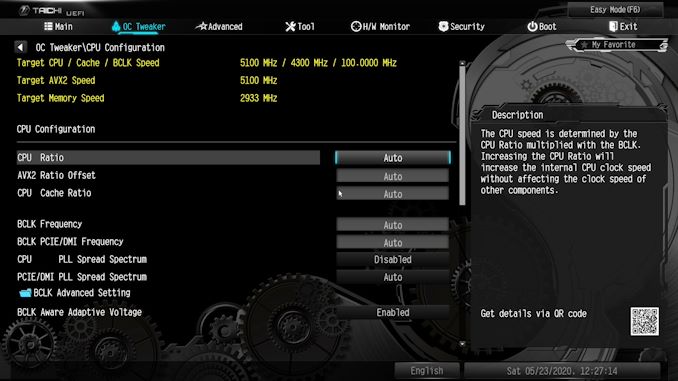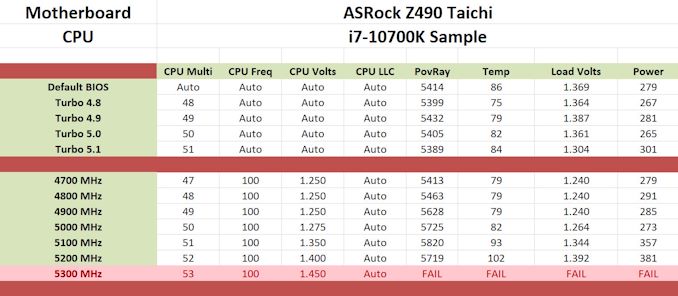The ASRock Z490 Taichi Motherboard Review: Punching LGA1200 Into Life
by Gavin Bonshor on May 27, 2020 9:00 AM ESTOverclocking
Experience with the ASRock Z490 Taichi
With Intel's 10th generation Comet Lake-S processors, overclocking on Z490 is very similar to Z390 in terms of settings and behaviour. The new processors run pretty hot under load and react differently depending on the quality of CPU cooler used. For optimal performance and based on our testing, it's recommended to use at least a 240 mm AIO with the Intel Core i7-10700K, with at least a 280 mm AIO on the Core i9-10900K. Despite Intel upgrading and refining its die through thinning and the use of soldered TIM, these still run toasty and with Intel's Thermal Velocity Boost adaptive up to 100 MHz extra when there's room for manoeuvre in temperature and power limits, better cooling should equate to better performance.
Overclocking using ASRock's Z490 Taichi firmware is a pleasant experience, with each of the three main overclocking segments (CPU, memory, Voltage) coming under its own menu within the OC Tweaker section. Provided with the firmware is four overclocking presets which range from 4.8 to 5.1 GHz with our testbed Core i7-10700K processor, which we have tested below. Users looking to overclock the CPU can simply increase the CPU Core ratio which goes up and down in 100 MHz increments, while voltage options for CPU VCore can be found within the voltage settings.
Memory overclocking can be done with a couple of clicks when using XMP 2.0 memory profiles, or users can customize these within the memory settings section. One thing of note is ASRock offers a wide variety of latencies for users to tweak, which can increase performance providing the memory has enough headroom for increase frequency, and the ability to run with tighter latencies. The ASRock Z490 Taichi firmware is stable to use, responsive (version 1.50), and aesthetically simple and pleasing.
Overclocking Methodology
Our standard overclocking methodology is as follows. We select the automatic overclock options and test for stability with POV-Ray and Prime95 to simulate high-end workloads. These stability tests aim to catch any immediate causes for memory or CPU errors.
For manual overclocks, based on the information gathered from the previous testing, starts off at a nominal voltage and CPU multiplier, and the multiplier is increased until the stability tests are failed. The CPU voltage is increased gradually until the stability tests are passed, and the process repeated until the motherboard reduces the multiplier automatically (due to safety protocol) or the CPU temperature reaches a stupidly high level (105ºC+). Our testbed is not in a case, which should push overclocks higher with fresher (cooler) air.
Overclocking Results
Overclocking an Intel Core i7-10700K using the ASRock Z490 Taichi was a pleasurable one with plenty of headroom and capability shown from the motherboard itself. We tested the four overclocking presets which range from 4.8 to 5.1 GHz, with some interesting results. The Turbo 4.8 profile actually performed a little worse in our POV-Ray testing than default settings, albeit with a lower heat threshold. The Turbo 4.9 and 5.0 profiles also didn't improve much compared with the default settings, which shows ASRock's default profile is quite aggressive. Testing the top Turbo 5.1 profile, it actually performed the worse in our POV-Ray testing, which also strangely presented us with the lowest load CPU VCore voltage readout.
Dialling in manual overclocks, we started at 4.7 GHz and extended this to 5.3 GHz. Overclocking on the ASRock Z490 Taichi at 4.7 GHz all-cores, we saw similar performance to stock, albeit with lower temperatures, but identical power draw. Going from 4.8 to 5.2 GHz proved effective in increasing performance which went up incrementally, along with the temperature. Power draw was a little inconsistent in this range with our 5.0 GHz test outputting lower power than at 4.7 GHz. The best overclock we could manage with 1.4 V on the CPU VCore was 5.2 GHz all-cores which performed slightly worse than 5.1 GHz, which could be put down to an anomaly, but power draw reached 381 W which is quite staggering and difficult to cool, even with our NZXT Kraken Z63 280 AIO Cooler. When changing the CPU Vcore to a defined amount, it would automatically change the LLC profile to level 1, which attributes to tighter and consistent VDroop when under load.
Overall it was easy to overclock with the ASRock Z490 Taichi and despite a couple of anomalies and inconsistencies in power draw and our POV-Ray results, there doesn't seem to be anything untoward or that would hinder the board's ability to overclock any of the Intel Comet Lake 10th gen processors, other than the heat generated of course.












57 Comments
View All Comments
Ian Cutress - Wednesday, May 27, 2020 - link
I still have a DDR booster :)YB1064 - Thursday, May 28, 2020 - link
Happy to take it off your hands if you don't need it. :)bigboxes - Wednesday, May 27, 2020 - link
It's funny, you had me up until DFI. I had a lan party NF4 board. I hated that thing. It was too difficult to get and keep stable. I wasn't a noob when it came out. Such a disappointment. I like tweaking my stuff, but no thanks. LolSpunjji - Thursday, May 28, 2020 - link
Can second this. The LAN party NF4 boards were absolute garbage - I had a friend RMA the same one twice, and the entire process took a year. What's the point of having the best OC features if your boards aren't stable at stock settings?alufan - Thursday, May 28, 2020 - link
And third garbage wouldnt overclock worth Toffee even running stock was a challenge all they had was fancy colours and a lot of rave reviewsYB1064 - Thursday, May 28, 2020 - link
I never said that the DF4 boards were reliable. They were at best betas, but I'll be damned if they didn't overclock like crazy. I've gone through about ~20 boards (NF4, NF4-SLI-DR, NF4-Expert) to find the best ones. It was a crapshoot, but man was it FUN!andanand - Wednesday, May 27, 2020 - link
Is there any reason someone would choose an i7 over an AMD cpu at the same price point?lmcd - Wednesday, May 27, 2020 - link
Microsoft still hasn't gotten around to nested Hyper-V on AMD -- unless it quietly made it into 2004 that released today.IGP is pretty useful on Linux still since AMD driver support tends to be late for new graphics architectures. A CPU-only workload on Linux would definitely favor Intel, as cheap AMD GPUs are ancient and Nvidia proprietary drivers are still annoying to use.
lmcd - Wednesday, May 27, 2020 - link
Nested Hyper-V sounds niche but anyone who wants to use the Windows 10X emulator needs it unfortunately.mooninite - Wednesday, May 27, 2020 - link
Hi, let's calm down on the FUD.You act like the only virtualization solution on Windows is Hyper-V. It's not. It's not a deal breaker for most people. Maybe for you... but not for most people.
IGP support is *equal* today (yes, the year is 2020) with Intel and AMD IGPs. All the way up to Ice Lake and Vega 3xxx APUs. Performance favors AMD IGPs. This support extends to video decoding and encoding, which is equal on both sides.
The NVIDIA driver is painless to use if you use a sane, well-maintained distribution that packages it for you.
Anything else you would like to debate? Some of your statement was true a decade ago, but times have changed for the better.